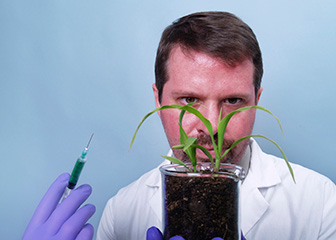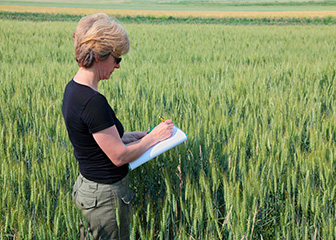How to Become an Agricultural or Food Scientist About this section

Agricultural and food scientists use data analysis skills to observe the results of their studies.
Agricultural and food scientists typically need at least a bachelor’s degree in animal science, food science, plant biology, or a related field. Employers may prefer or require a master’s or doctoral degree.
Education
Undergraduate coursework for agricultural and food scientists varies by specialty, but common fields of degree include biology, physical science, and agriculture. Students may choose to major in a specific concentration within agriculture, such as animal, crop, or food science. Degrees in related sciences, such as biology, chemistry, and physics, or in a related engineering specialty also may qualify people for many agricultural science jobs. Every state has at least one land-grant college that offers agricultural science degrees. Many other colleges and universities also offer agricultural science degrees or related courses.
Many people with bachelor’s degrees in agricultural sciences find work in related jobs rather than becoming an agricultural or food scientist. For example, a bachelor’s degree in agricultural science is a useful background for farming, ranching, agricultural inspection, farm credit institutions, or other companies in the agrifood system. Combined with coursework in business, agricultural and food science could be a good background for managerial jobs in farm-related or ranch-related businesses. For more information, see the profile on farmers, ranchers, and other agricultural managers.
Some agricultural and food scientists earn advanced degrees, and a master’s or doctoral degree may be required for some jobs. For example, a Ph.D. may be required for some research positions in specialized topics. Advanced research topics include genetics, animal reproduction, agronomy, and biotechnology, among others. Advanced coursework also emphasizes statistical analysis and experiment design, which are important as Ph.D. candidates begin their research and work with big datasets. During graduate school, there is additional emphasis on lab work and original research, in which prospective agricultural and food scientists conduct experiments and sometimes supervise undergraduates.
Licenses, Certifications, and Registrations
Some agricultural and food scientists may need a license, particularly those who plan to work in plant and soil sciences. Licensing requirements vary by state but generally include holding a bachelor’s degree with a certain number of credit hours in either plant or soil science, working under a licensed scientist for a certain number of years, and passing an exam. Licensed plant and soil scientists may require additional education credits or training every few years to maintain their licenses. Information on state licensing board requirements is available from CareerOneStop.
Certifications are generally not required for agriculture and food scientists, but they can be useful in advancing one’s career. Information on certifications is available from CareerOneStop.
Other Experience
Internships are highly recommended for prospective agricultural and food scientists. These internships may lead to opportunities for full-time employment and provide students with hands-on experience.
Important Qualities
The following are examples of qualities that are important for these workers to perform their duties. For more information, visit the Employment Projections (EP) skills data page.
Communication skills. Agricultural and food scientists must explain their studies both verbally and in writing, including what they were trying to learn, the methods they used, what they found, and what they think the implications of their findings are. They must also communicate well when working with others, including technicians and student assistants.
Critical-thinking skills. Agricultural and food scientists must use their expertise to determine the best way to answer a specific research question.
Data-analysis skills. Agricultural and food scientists collect data using a variety of methods, including quantitative surveys. They must then apply standard data analysis techniques to understand the data and get the answers to the questions they are studying.
Math skills. Agricultural and food scientists must have a sound grasp of mathematical concepts.
Detail-oriented skills. Agricultural and food scientists conduct experiments that require precise observation of samples and other data. Any mistake could lead to inconclusive or inaccurate results.
 United States Department of Labor
United States Department of Labor












